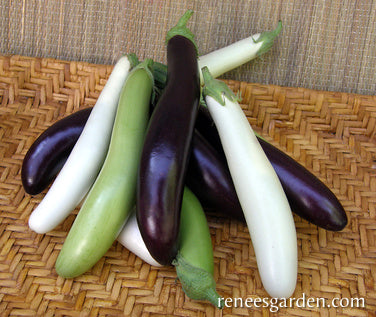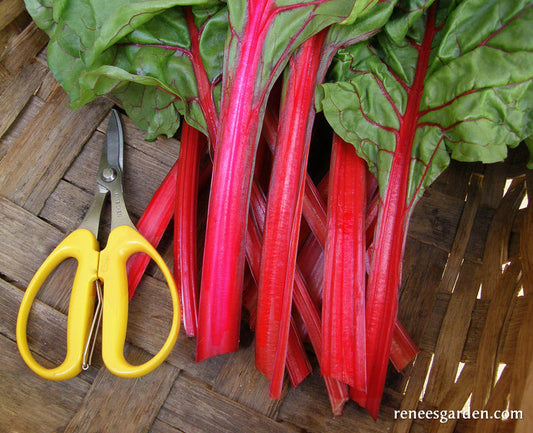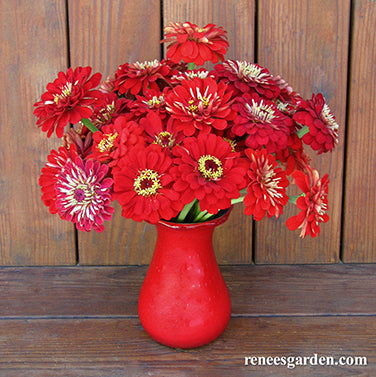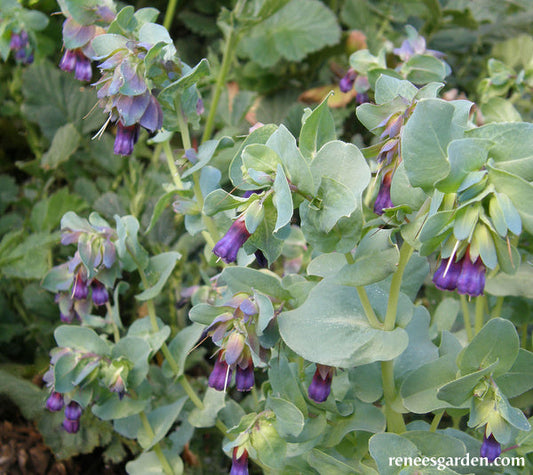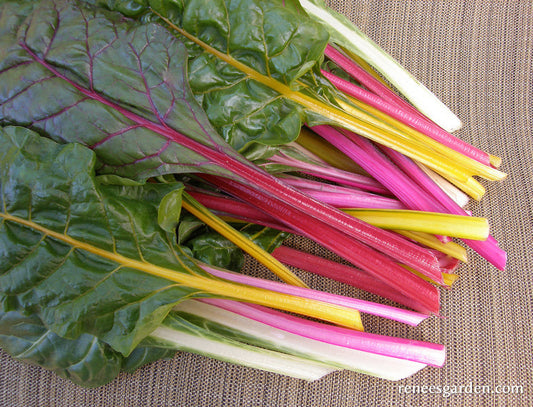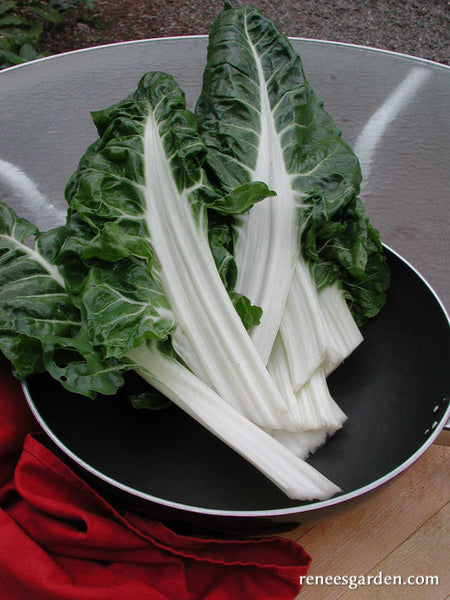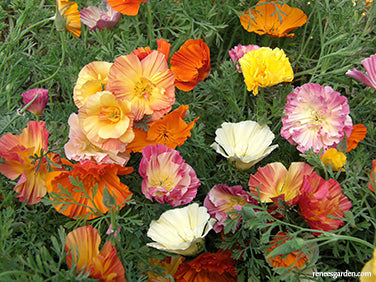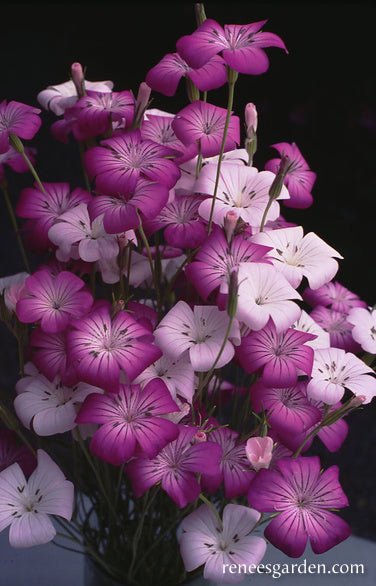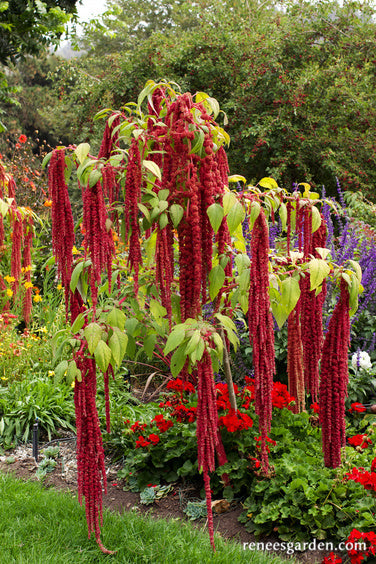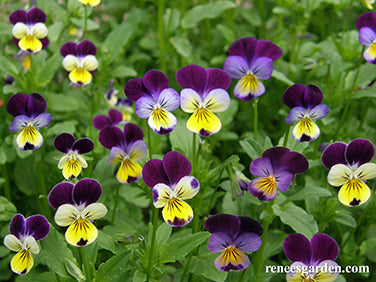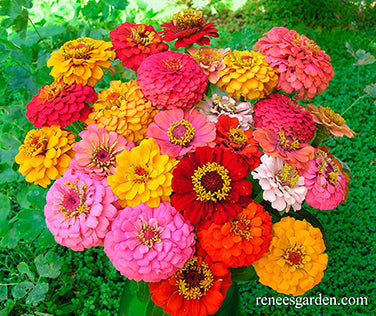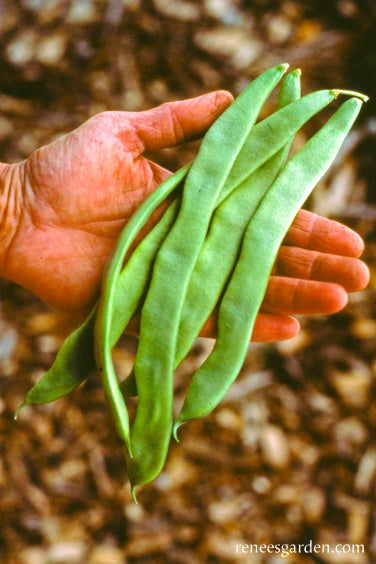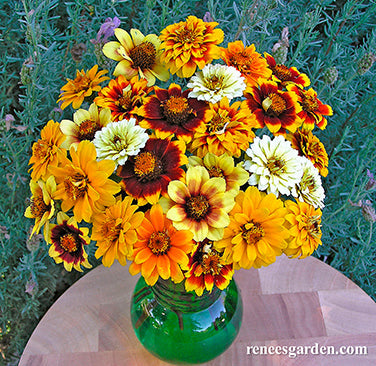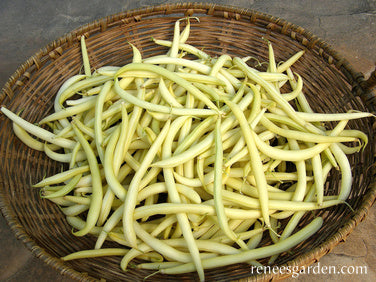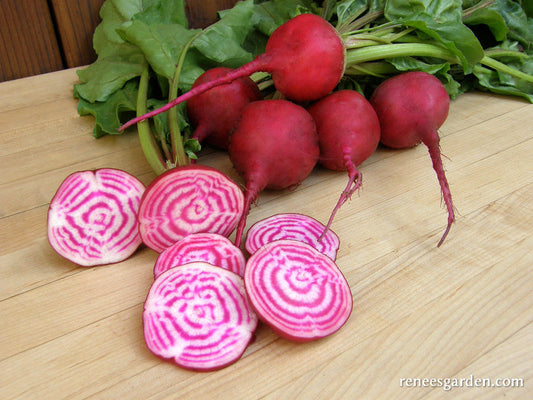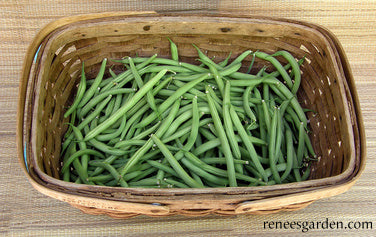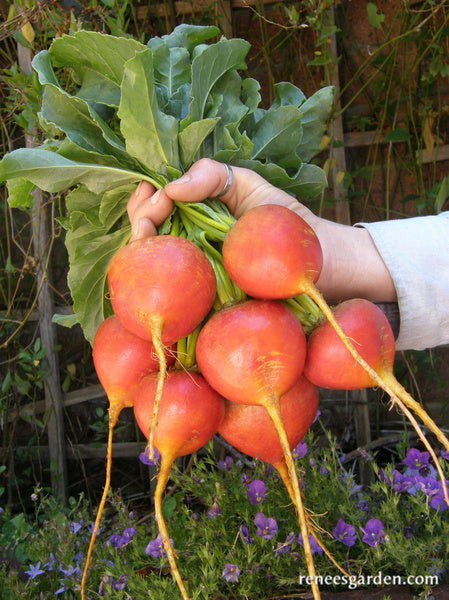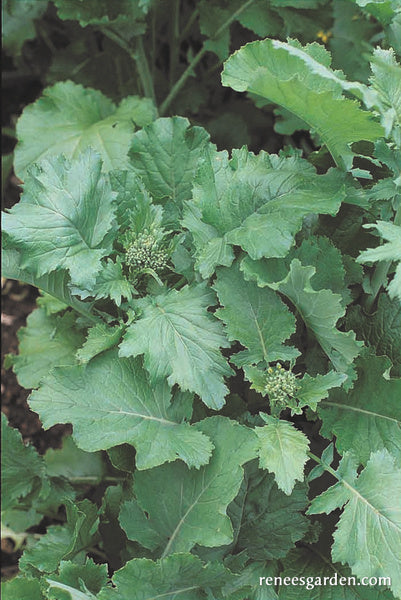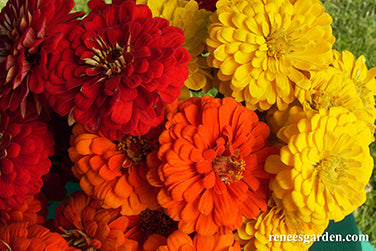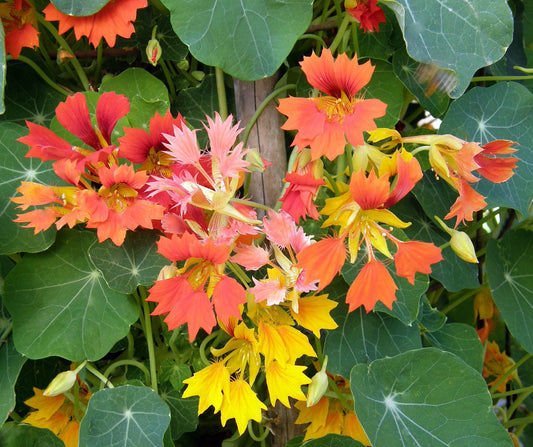Heirloom Selections
Old Varieties with Exceptional Beauty and Flavor
Our heirloom selections have been preserved and kept true to their beloved local history, often exhibiting unusual colors, shapes or flavors.
-
Heirloom Eggplants Asian Mix
BEST TO START INDOORS
In early spring, start indoors about 2 months before outdoor night temperatures are reliably in the 50-55°F (10-13°C) range. Sow seeds 1/4 inch deep and 1 inch apart in a container of seed starting mix. Keep moist and warm 80-85°F (27-30°C) and provide a strong light source until ready to plant outside. When seedlings are 2 inches tall, transplant into deeper individual containers. Maintain at 70-75°F (21-24°C). Feed with half-strength fertilizer every 2 weeks until weather is warm enough to gradually acclimate seedlings to outdoor conditions. Transplant 2 feet apart into rich soil in full sun.
GROWING NOTES
Don’t transplant these heat-lovers outdoors until nights stay securely above 55°F (13°C). Prepare soil well with aged manure or compost. Plant only robust seedlings with well-developed roots and mulch well. Fertilize plants regularly throughout the season.
HARVEST AND USE
Pick when fruits have sized up and are firm fleshed and glossy. Slice 1/2 inch thick, brush with olive oil and broil until tender. Then layer with a rich tomato sauce, fresh herbs and several cheeses to make Eggplant Parmesan. Bake whole in a hot oven, then scoop out flesh and mash with garlic, olive oil, lemon juice and chopped parsley for a savory dip to serve on toasted pita bread.
Regular price $4.89Sale price $4.89Unit price / per -
Gourmet Ruby Chard Scarlet Charlotte
START SEEDS OUTDOORS
In early spring when danger of hard frost is over, sow seeds in well-worked, fertile soil in full sun. Sow seeds 1/2 inch deep and 2 inches apart in rows 10 inches apart. Firm soil well over these irregularly shaped seeds to ensure good germination. If first sowing germinates unevenly, plant more seed in the rows as seedlings catch up quickly. Thin when seedlings are large enough to handle, using thinnings as early greens. Final spacing should be 12 to 18 inches apart.
GROWING NOTES
Chard grows well in a wide range of conditions and can take some frost. In mild winter areas, it can be grown year-round. Thin seedlings well so the large 2 foot tall, vase-shaped plants have room to mature.
HARVEST AND USE
Begin harvesting when plants are well established and have 6 to 8 stalks. Both the crunchy succulent stalks and leaves make great eating. Chop and sauté chard with garlic and olive oil or pair with sautéed mushrooms and onions. Try steamed and topped with a sprinkle of vinegar or fresh lemon juice. Use like spinach in lasagna or minestrone soup.
Regular price $2.99Sale price $2.99Unit price / per -
Heirloom Cutting Zinnias Moulin Rouge
ANNUAL
Summer/fall bloom
Frost tenderEASY TO START DIRECTLY IN THE GARDEN
Sow seeds in well-worked soil in full sun when danger of frost is past and weather is warm and above 50°F (10°C) both day and night. Space seeds 2 to 3 inches apart in rows 12 inches apart, cover about 1/2 inch deep and gently firm soil. Keep soil evenly moist while awaiting germination.
TO START EARLY INDOORS
Four weeks before last frost date, sow seeds 1/2 inch deep and 3 inches apart in a container of seed starting mix. Keep warm and moist and provide a strong light source until seedlings are ready to plant outside when temperatures rise above 50°F (10°C) day and night.
THIN OR TRANSPLANT
Space seedlings 8 to12 inches apart when large enough to handle so plants have good air circulation and enough elbow room to grow and bloom freely.
GROWING NOTES
Zinnias grow readily in ordinary garden soil in full sun. For large and abundant flowers, thin before seedlings get crowded; adequate spacing and regular, even watering help keep zinnias productive and discourages mildew. Pick when flower blossoms first open and petals are tight for longest vase life. Cut long stems well back into the plant to keep plants branching low and producing best blooms for summer long bouquets.Regular price $3.39Sale price $3.39Unit price / per -
Hummingbird Cerinthe Pride of Gibraltar
HARDY ANNUAL
Summer/fall bloom
TO START OUTDOORS
In spring, once all danger of frost is past, sow seed directly where plants are to grow in ordinary well-drained soil in full sun. In mild climates, Cerinthe can also be sown in fall for spring blooms. Poke the large seeds into the soil about 3⁄4 inch deep and 4 to 6 inches apart and firm soil gently over them.
TO START EARLY INDOORS
Start seeds indoors in 4 inch pots about 4 to 6 weeks before last frost date. Keep moist, but not soggy and provide a strong light source. Once seedlings are 4 to 6 inches tall, acclimate to outdoor conditions and transplant into a sunny spot, in well-drained garden soil. Thin or transplant seedlings 8 to 12 inches apart. Avoid disturbing seedling roots.
GROWING NOTES
Cerinthe prefers full sun, but can take dappled shade, although plants will be more rangy in habit. Be patient; plants are undistinguished until they come into bloom. By late spring, the dramatic blue bracts will turn more purple at the tips, then the clusters of purple bells trimmed with a white edge unfurl. Grow near pastel cleome or cosmos for an exciting color contrast.
Regular price $4.69Sale price $4.69Unit price / per -
Heirloom Chard Garden Rainbow
START SEEDS OUTDOORS
In early spring, when danger of frost is over, sow seeds in well-worked, fertile soil in full sun. Sow seeds 1/2 inch deep and 1 inch apart in rows 10 inches apart, or broadcast thinly for bed planting. Firm soil well over these irregularly shaped seeds to ensure good germination. If first sowing germinates unevenly, plant more seed as seedlings catch up quickly. When large enough to handle, thin seedlings to final spacing of 8 to 10 inches apart so these large plants have room to grow and mature. Transplant extras or enjoy young thinnings as early greens and salads.
GROWING NOTES
Chard grows well in a wide range of conditions and can take some light frost. In mild winter areas, it can be grown year round. Give seedlings enough room, because chard grows into large vase-shaped plants 2 feet tall.
HARVEST AND USE
Begin harvesting when plants are well established and have at least 6 to 8 leaves. Both stalks and leaves make great eating. Chop and steam or sauté with garlic and olive oil. Use like spinach in lasagna or minestrone soup. Try tasty chard leaves stuffed and poached in broth with a dash of olive oil and fresh lemon.
Regular price $4.89Sale price $4.89Unit price / per -
Heirloom Chard Italian Silver Rib
START SEEDS OUTDOORS
In early spring when danger of hard frost is over, sow seeds in well-worked, fertile soil in full sun. Sow seeds 1/2 inch deep and 2 inches apart in rows 10 inches apart, or broadcast very thinly for bed planting. Firm soil well over these irregularly shaped seeds to ensure good germination. If first sowing germinates unevenly, plant more seed in the rows as seedlings catch up quickly. Thin when seedlings are large enough to handle, using thinnings as early greens. Final spacing should be 12 to 18 inches apart so chard plants have room to mature.
GROWING NOTES
Chard grows well in a wide range of conditions and can take some frost. In mild winter areas, it can be grown year round. Thin seedlings well as chard grows into large vase-shaped plants 2 feet tall.
HARVEST AND USE
Begin harvesting when plants are well established and have 6 to 8 stalks. Both the crunchy succulent stalks and leaves make great eating. Chop and sauté chard with garlic and olive oil or pair with sautéed mushrooms and onions. Try steamed and topped with a sprinkle of vinegar or fresh lemon juice. Use like spinach in lasagna or minestrone soup.
Regular price $2.99Sale price $2.99Unit price / per -
Heirloom Amaranth Cinco De Mayo
ANNUAL
Summer/fall color
Frost tenderEASY TO START OUTDOORS
Sow seeds in full sun in ordinary well-worked garden soil in springtime once night temperatures reach 50°F (10°C). Space tiny seeds as thinly as possible. Cover very lightly with soil and keep moist until seedlings emerge in 7 to 10 days.
TO START EARLY INDOORS
Five to six weeks before last frost date, sow seeds 1 inch apart in individual pots or a container of seed starting mix, cover lightly and keep moist. Provide a strong light source until seedlings are ready to plant outside once danger of frost is over. Gradually acclimate to outdoor conditions before transplanting.
THIN OR TRANSPLANT
Final seedling spacing should be 12-18 inches apart, so they have room to grow and mature.
GROWING NOTES
Plants explode with sky rocket colors when they come to maturity in late summer. These easy to grow, dramatic foliage Amaranths prefer a warm, dry location in good garden soil. When established, the tall bushy plants can tolerate drought and need no extra fertilizer, but must have good drainage. For better branching, pinch the main bud when plants are about 18 inches tall.
Regular price $2.99Sale price $2.99Unit price / per -
California Poppies Dancing Ballerinas
ANNUAL
Spring/Summer/Fall bloom
Can handle light frostBEST TO START DIRECTLY IN THE GARDEN
Sow seeds directly into a finely textured, well-drained garden bed in full sun as early in spring as the ground can be worked. Plant as early as possible in spring, as poppies can handle light frost and bloom best and longest when plants get a good start in cool weather. In mild winter climates, Poppies can also be sown in late fall to overwinter for spring bloom. Except in very poor soil, these California poppies will grow and flower readily with no added fertilizer. Space seeds several inches apart, cover no more than 1/4 inch deep, and firm soil gently. Keep soil moist as seedlings emerge. If seedlings come up very thickly, thin poppies early but delay final thinning until seedlings are well established in spring. Space seedlings, 4-6 inches apart as plants need room to grow and bloom.
GROWING NOTES
When mature, poppy plants can handle dry conditions, but they will always bloom brighter and longer if regularly watered and are kept well weeded. Poppies are pretty cut flowers if brought indoors just as buds begin to open. At season’s end, allow spent flowers to form pods and drop seed if you want poppies to self-sow for next year's spring flowers.Regular price $3.99Sale price $3.99Unit price / per -
Agrostemma Purple Queen and Pink Contessa
HARDY ANNUAL
Spring/summer bloom
Frost HardyBEST TO PLANT DIRECTLY IN THE GARDEN
Mild Winter Climates: Sow seeds either in early spring or in late fall to germinate and form deep roots for a long spring bloom.
Cold Winter Climates: Sow seed as early in spring as soil can be worked. Space seeds 1 to 2 inches apart in well-drained soil in full sun or partial shade in hot areas. Cover 1/4 inch deep, firm soil and keep seed bed moist. Be patient; germination takes 14 to 21 days. After seedlings are well established and 2 or 3 inches tall, thin or transplant 8 to 10 inches apart. Keep plants well watered and weeded for best performance.
TO START EARLY INDOORS
Sow seeds 1 inch apart in seed-starting mix, 4 to 6 weeks before last expected frost. Cover 1/4 inch deep, keep moist and provide a good light source until ready to plant outside when the weather warms up. Thin or transplant seedlings 8 to 10 inches apart when large enough to handle.
GROWING NOTES
Spring Sowing: plant seed as early as soil can be worked to get sturdy plants that will provide many weeks of graceful bloom.
Fall Sowing: wait until soil has cooled in late fall. Extend the blooming season by cutting faded flowers before seed pods develop.
Regular price $3.39Sale price $3.39Unit price / per -
Heirloom Amaranth Love Lies Bleeding
ANNUAL
Summer/fall bloom
Frost tenderEASIEST TO START OUTDOORS
Sow seeds in full sun in ordinary well-worked garden soil when weather is warm and settled and all danger of frost is past. Space tiny seeds 3 to 4 inches apart or as thinly as possible. Cover lightly and keep moist until seedlings emerge in 7 to 10 days.
TO START EARLY INDOORS
Several weeks before last frost date, sow seeds 1 inch apart in containers or individual pots of well-drained seed starting mix, cover lightly and keep moist. Provide a strong light source until seedlings are ready to plant outside when weather is warm and settled and before seedlings get too crowded. Thin or transplant seedlings 18 to 24 inches apart when seedlings are large enough to handle so the large plants will have room to grow.
GROWING NOTES
This dramatic annual is easy to grow, sun loving and drought-tolerant. The large plants make striking garden companions to taller flowers like Sunflowers or Tithonia. Love Lies Bleeding’s draping blossoms with their rich color and unusual touchable texture are long-lasting focal points for large arrangements. Let some flowers set seeds in the garden to self sow.
Regular price $2.99Sale price $2.99Unit price / per -
Heirloom Edible Flowers Grandma's Johnny Jump Ups
PERENNIAL GROWN AS ANNUAL
Spring bloom
Can handle frostBEST TO PLANT DIRECTLY IN THE GARDEN
In Mild Winter Climates, sow seeds in fall and they will form deep roots over winter for a long spring bloom.
In Cold Winter Areas, sow in spring as soon as soil can be worked.
Violas can handle light frosts and bloom best when they get a good start in cool spring weather. Sow seeds 1 inch apart in well-drained soil in full sun. Cover 1/4 inch deep, firm soil and keep seed bed moist. Be patient; germination takes 14 to 21 days. When large enough to handle, thin or transplant seedlings to 4 to 5 inches apart.
To Start Early Indoors: Sow seeds 1 inch apart in seed starting mix, 8 to 10 weeks before last frost. Cover 1/4 inch deep, keep moist & provide a good light source until ready to plant outside when weather warms up. Transplant 4 to 5 inches apart when large enough to handle.
GROWING NOTES
These carefree plants are covered with cheerful flowers throughout spring & early summer. After initial flowering, cut plants back to several inches tall for another flush of bloom if the weather is not too hot. In milder climates, Johnny Jump Ups will self sow readily & come back each season. The dainty edible blossoms taste of wintergreen. They make great garnishes & are also perfect for candying.Regular price $3.39Sale price $3.39Unit price / per -
Heirloom Zinnias Cut and Come Again
ANNUAL
Summer/fall bloom
Frost tenderTO START DIRECTLY IN THE GARDEN
Sow seeds in a well-worked seed bed in full sun when danger of frost is past and weather is warm and above 50°F (10°C) both day and night. Space seeds 3 inches apart in rows 12 inches apart, cover about 1/2 inch deep and gently firm soil. Keep soil evenly moist while awaiting germination.
TO START EARLY INDOORS
Four to five weeks before last frost date, sow seeds 1/2 inch deep and 3 inches apart in a container of seed starting mix. Keep warm and moist and provide a strong light source until seedlings are ready to plant outside when temperatures rise above 50°F (10°C) day and night.
THIN OR TRANSPLANT
Space seedlings 12 inches apart when large enough to handle to give plants room to mature and provide good air circulation.
GROWING NOTES
Zinnias grow readily in ordinary garden soil in full sun. For large and abundant flowers, thin before seedlings get crowded; adequate spacing and regular, even watering helps keep zinnias productive and discourages mildew. Pick when flower blossoms first open and petals are tight for longest vase life. Cut long stems well back into the plant to keep plants branching low and producing best blooms for summer long bouquets.Regular price $2.99Sale price $2.99Unit price / per -
Early Pole Beans Spanish Musica
START SEEDS OUTDOORS
In spring once weather is warm and night temperatures stay securely above 55°F (13°C), plant seeds in well-worked, fertile soil in full sun. Erect strong stakes, tripod poles, or trellis at planting time to support vines. Plant seeds 1 inch deep and 4 inches apart along a trellis, or if planting around tripods or stakes, plant 4 to 6 seeds 4 inches from each pole, thinning seedlings to 3 best plants.
GROWING NOTES
Tender crispy beans are an easy reliable crop to grow, but do not plant seeds too early as cold conditions prevent good germination. If first sowing comes up unevenly, replant right away; new seedlings will catch up quickly. Birds are often attracted to young bean seedlings, so watch carefully and protect with netting or floating row covers if necessary. Avoid cultivating plants or picking pods when plants are wet.
HARVEST AND USE
Musica’s strong vines are heavy bearers, so plan to harvest often. The more you pick, the more plants will produce. Harvest when beans are broad and 7 to 9 inches long. Slice in pieces and cook just until tender to enjoy their fine flavor and meaty texture. Serve hot, or cool and toss with herbed vinaigrette for a delicious green bean salad.
Regular price $4.99Sale price $4.99Unit price / per -
Heirloom Butterfly Zinnias Persian Carpet
ANNUAL
Summer/fall bloom
Frost tenderTO START DIRECTLY IN THE GARDEN
Sow seeds in well-worked soil in full sun when danger of frost is past and temperatures are above 50°F (10°C) both day and night. Space seeds 2 to 3 inches apart in rows 12 inches apart, cover about 1/2 inch deep and gently firm soil. Keep evenly moist while awaiting germination.
TO START EARLY INDOORS
Four weeks before last frost date, sow seeds 1/2 inch deep and 3 inches apart in containers of seed starting mix. Keep warm and moist and provide a strong light source. Feed with 1/2 strength fertilizer every 2 weeks. Just as soon as seedlings have several sets of true leaves, plant outdoors when temperatures stay above 50°F (10°C) at night.
THIN OR TRANSPLANT
Space seedlings 8 to 10 inches apart when large enough to handle to provide good air circulation and give plants room to mature.
GROWING NOTES
Zinnias grow readily in ordinary garden soil in full sun. Be sure to thin before seedlings get crowded; adequate spacing and regular even watering help keep zinnias productive and disease free. Grow colorful Persian Carpet in beds or borders, or combine with white alyssum, dwarf marigolds, petunias and salvia for season-long bloom in terracotta pots and color bowls.Regular price $2.99Sale price $2.99Unit price / per -
Pole Filet Beans French Gold
START SEEDS OUTDOORS
In late spring, once night temperatures stay securely above 55°F, plant seeds in well-worked, fertile soil in full sun. Erect strong stakes, tripod poles or trellis at planting time to support vines. Plant 1 inch deep and 4 inches apart along a trellis; around tripods or stakes, plant 4 to 6 seeds about 4 inches from each pole, thinning seedlings to 3 best plants per pole.
GROWING NOTES
Beans are an easy and reliable crop, but don’t plant seeds too early; cold conditions prevent good germination. If first sowing comes up unevenly, replant right away; new seedlings will catch up quickly. Birds are attracted to young seedlings; watch carefully and protect with netting if necessary. Avoid harvesting beans in wet conditions.
HARVEST AND USE
For the best yields, pick beans frequently, at least every 2 or 3 days. Filet beans are meant to be eaten when pods are long and slender, so harvest the tender pods early, when they are still pencil-thin. These elegant gourmet beans taste best freshly harvested and quickly steamed or sautéed. When blanched and tossed in an herbed vinaigrette with salad greens and fresh herbs like Italian parsley, basil or a little fresh thyme, French Gold beans make a beautiful and delicious salad.
Regular price $4.69Sale price $4.69Unit price / per -
Heirloom Beets Traditional Chioggia
START SEEDS DIRECTLY OUTDOORS
In early spring, when danger of hard frost is over, sow seeds in well-worked, fertile soil in full sun. Sow seeds 1 inch apart and 1/2 inch deep in rows 8-10 inches apart, or broadcast thinly for bed planting. Firming soil well over these irregularly shaped seeds will ensure best germination. If first sowing comes up unevenly, sow more seeds as seedlings will catch up fast. When large enough to handle, carefully thin seedlings to 3 to 4 inches apart so growing beets have room to size up.
GROWING NOTES
For best quality, tender roots, sow seeds before midsummer heat and again in late summer to early fall — in cold climates, allow at least 10 weeks before fall frosts. Keep soil evenly moist throughout the season. Be sure to thin seedlings several times when plants are small, as beets grow best if given enough room.
HARVEST AND USE
After thinning seedlings, use tender young tops for nutritious, flavorful steamed greens. Harvest baby beets at 1 to 2 inches in diameter, or let roots grow as large as desired. Garden fresh beets cook quickly. They are delicious steamed, boiled or baked whole in their skins like potatoes, then peeled for concentrated flavor. Chioggia beets are especially mild and sweet tasting.
Regular price $4.89Sale price $4.89Unit price / per -
Heirloom Bush Beans Provider
START SEEDS OUTDOORS
In spring, once weather is warm and settled and night temperatures stay securely above 55°F (13°C) plant seeds in well-worked, fertile soil in full sun. Poke seeds in 1 inch deep and 4 inches apart in rows 1½ to 2 feet apart. Make several sowings 2 to 3 weeks apart until the end of June to provide long continued harvests.
GROWING NOTES
Tender crispy garden beans are an easy and reliable crop to grow, but don't plant seeds too early as cold conditions prevent good germination. If first sowing comes up unevenly, replant right away; new seedlings will catch up quickly. Birds are often attracted to young bean seedlings, so watch carefully and protect with netting or floating row covers if necessary. Avoid cultivating plants or picking pods when plants are wet.
HARVEST AND USE
The vigorous plants bear strong harvests of top quality pods that hold well without getting stringy. The more you pick, the more the plants will produce, and the nitrogen fixing bacteria on the roots of bean plants actually improves your soil. Sow another crop about three weeks after your first planting and you’ll have a welcome second harvest in late summer. Enjoy tasty Provider beans cooked just until tender crisp. The pods also freeze well if blanched first.
Regular price $4.89Sale price $4.89Unit price / per -
Gourmet Beets Golden
START SEEDS DIRECTLY OUTDOORS
In early spring, when danger of hard frost is over, sow seeds in well-worked, fertile soil in full sun. Space seeds 1 inch apart in rows 8 to 10 inches apart, or broadcast evenly for bed planting. Firming soil well over these irregularly shaped seeds will ensure best germination. If first sowing comes up unevenly, sow more seeds as seedlings will catch up fast. When large enough, carefully thin seedlings to 3 to 4 inches apart so growing beets have room to size up.
GROWING NOTES
For best quality, tender roots, sow seeds before midsummer heat and again in late summer to early fall—in cold climates, allow at least 10 weeks before fall frosts. Keep soil evenly moist throughout the season. Be sure to thin seedlings several times when plants are small, as beets grow best if given enough room.
HARVEST AND USE
After thinning seedlings, use tender young tops for nutritious, flavorful steamed greens. Harvest baby beets at 1 to 2 inches in diameter, or let roots grow as large as desired. Garden fresh beets cook quickly. They are delicious steamed, boiled or baked whole in their skins like potatoes, then peeled for wonderful color and sweet concentrated flavor. Golden color does not “bleed” like red beets.
Regular price $3.99Sale price $3.99Unit price / per -
Heirloom Dill Leafy Diana
EASIEST TO PLANT OUTDOORS
In early spring, sow dill seed directly into well-drained garden soil 1 to 2 inches apart in rows 6 inches apart in full sun and cover seeds 1/4 inch deep. Make small sowings every few weeks to have successive harvests of fresh leaves. Keep seed bed evenly moist while awaiting germination in 7 to 14 days.
TO START INDOORS
Sow dill seed thinly in individual pots of seed starting mix. Cover 1/4 inch deep and keep moist as seedlings emerge in 7 to 14 days. Provide a good light source. Transplant when seedlings are about 2 inches tall after gradually acclimating to outdoor conditions. Don’t let seedlings get crowded before planting outside.
THIN OR TRANSPLANT
Space groups of 2 or 3 seedlings about 4 inches apart when seedlings are large enough to handle.
GROWING NOTES
Keep plants well watered and thinned; crowded seedlings won’t make the lush growth desired for fresh leaf harvests and will form seed heads too early. Make several successive sowings for plenty of leafy dill fronds followed by seed heads to use for pickles and other savory dishes.
Regular price $4.89Sale price $4.89Unit price / per -
Heirloom Broccoli Raab Super Rapini
START SEEDS DIRECTLY IN THE GARDEN
In very early spring as soon as ground can be worked, prepare a well-drained, fertile garden bed in full sun. Sow seeds 2 inches apart in rows 6 to 8 inches apart. Cover 1/4 inch deep and keep soil evenly moist to ensure good germination. When seedlings are 3 to 4 inches tall, thin to stand 4 to 6 inches apart.
GROWING NOTES
Sow Broccoli Raab in cool early spring weather, about the same time as you plant turnips and radishes. Consistent moisture, early thinning and an adequate supply of nitrogen will encourage the quick growth needed to produce tender juicy shoots with plump buds. Use non-toxic B.T. (Bacillus thuringiensis) products to control caterpillar pests as necessary. Make several sowings a week apart for a continuous harvest. Sow again in late summer for a fall crop.
HARVEST AND USE
Harvest both leaves and flowering stalks at 7 to 8 inches tall, when they are still tender and juicy and the flower buds are plump and closed. After cutting, water plants and feed with fish emulsion solution to get a second harvest in a few weeks. Enjoy the hearty flavor of these vitamin-rich greens by briefly steaming or prepare traditionally by first blanching quickly in a boiling water bath, and then sautéing them in olive oil with chopped garlic.
Regular price $3.39Sale price $3.39Unit price / per -
Cactus Zinnias Heirloom Raggedy Anne
ANNUAL
Summer/fall bloom
Frost tenderTO START DIRECTLY IN THE GARDEN
Sow seeds in a well-worked seedbed in full sun when danger of frost is past and weather is warm and settled. Space seeds 2 to 3 inches apart in rows 12 inches apart, cover about 1/2 inch deep and gently firm soil. Keep soil evenly moist while awaiting germination.
TO START EARLY INDOORS
One month before last frost date, sow seeds 1/2 inch deep and 3 inches apart in a container of seed starting mix. Keep moist and provide a strong light source until seedlings are ready to plant out. Gradually acclimate to outdoor conditions before transplanting.
THIN OR TRANSPLANT
Space seedlings 10 to 12 inches apart to give plants room to mature.
GROWING NOTES
Zinnias grow effortlessly in ordinary garden soil in full sun. For large and abundant flowers, thin before seedlings get crowded; adequate spacing and regular even watering will ensure free flowering and discourage mildew. Pick flowers often by cutting long stems well back into the plant to keep them branching from below and producing best blooms for bright summer-long bouquets.Regular price $2.99Sale price $2.99Unit price / per -
Cutting Zinnias Hot Crayon Colors
ANNUAL
Summer/fall bloom
Frost tenderTO START DIRECTLY IN THE GARDEN
Sow seeds in fertile, well-drained soil in full sun when danger of frost is past and weather is warm and above 50°F (10°C) both day and night. Space seeds 3 inches apart in rows 12 inches apart, cover 1/2 inch deep and gently firm soil. Keep soil evenly moist while awaiting germination.
TO START EARLY INDOORS
One month before last frost, sow seeds 1/2 inch deep and 3 inches apart in seed starting mix. Keep warm and moist and provide a strong light source until seedlings are ready to plant outside when temps rise above 50°F (10°C) day and night.
THIN OR TRANSPLANT
Space seedlings 8-12 inches apart when large enough to handle to give plants room to mature and provide good air circulation.
GROWING NOTES
To ensure sufficient air circulation and abundant blossoms, thin before seedlings get crowded; adequate spacing and regular, even watering helps keep zinnias productive and discourages mildew. Pick when flower blossoms first open and petals are tight for longest vase life. Cut long stems well back into the plant to keep plants branching low and producing best blooms for summer long bouquets.Regular price $2.99Sale price $2.99Unit price / per -
Heirloom Broccoli Raab Early Rapini
START SEEDS DIRECTLY IN THE GARDEN
In very early spring as soon as ground can be worked, prepare a well-drained, fertile garden bed in full sun. Sow seeds 2 inches apart in rows 6 to 8 inches apart. Cover 1/2inch deep and keep soil evenly moist to ensure good germination. When seedlings are 3 to 4 inches tall, thin to stand 4 to 6 inches apart.
GROWING NOTES
Sow Broccoli Raab in cool early spring weather, about the same time as you plant turnips and radishes. Consistent moisture, early thinning and an adequate supply of nitrogen will encourage the quick growth needed to produce tender juicy shoots with plump buds. Use non-toxic B.T. (Bacillus thuringiensis) products to control caterpillar pests as necessary. Make several sowings a week apart for a continuous harvest. Sow again in late summer for a fall crop.
HARVEST AND USE
Harvest both leaves and flowering stalks at 7 to 8 inches tall, when stalks are still tender and juicy with closed buds. After cutting, water plants and feed with fish emulsion solution to get a second harvest in a few weeks. Enjoy the hearty flavor of these vitamin-rich greens by briefly steaming or prepare traditionally by first blanching them quickly in boiling water and then sautéing them in olive oil with chopped garlic, just until tender.
Regular price $4.89Sale price $4.89Unit price / per -
Heirloom Nasturtiums Climbing Phoenix
ANNUAL
Spring/Summer/Fall bloom
Frost tenderEASY TO START OUTDOORS
Sow seeds in spring once all danger of frost is over in full sun (or part shade in hot climates). Nasturtiums need no added fertilizer in most soils. Poke seeds into well-worked soil about 1 inch deep and 3 to 4 inches apart. Press soil firmly over the seeds and keep moist. When seedlings are large enough to handle, thin to stand 10 inches apart, or 6 to 8 inches apart if training seedlings up vertical supports.
TO START EARLY INDOORS
Sow 2 seeds each in individual 4-inch pots of well-drained seed starting mix 3 weeks before last expected frost date. Cover 1 inch deep. Provide a strong light source. When seedlings have several sets of leaves, pinch out the weaker seedling leaving 1 seedling per pot. When weather is evenly in the 50°F (10°C) range, gradually acclimate to outdoor conditions. Transplant as above in full sun.
GROWING NOTES
Climbing nasturtiums are easy to grow in any well-drained soil. You’ll need to train young plants onto their supports with loose ties, then they’ll climb easily and bloom non-stop. Do not let plants dry out during blooming season. If aphids become a problem, wash them off with a strong spray of water or spray with non-toxic Safer’s Soap solution. Phoenix’s bright confetti like blossoms are true summer beacons for hungry hummingbirds.
Regular price $3.99Sale price $3.99Unit price / per

